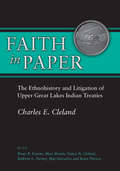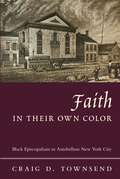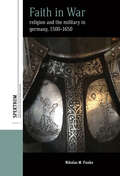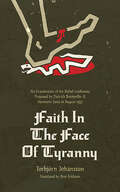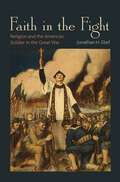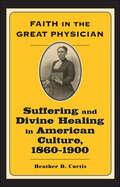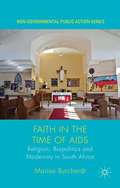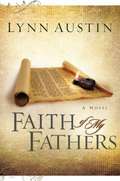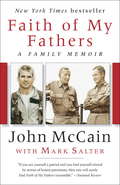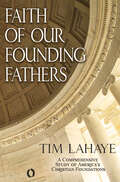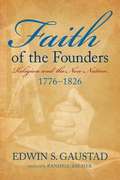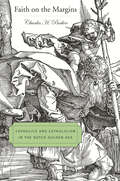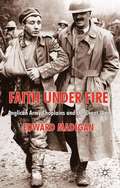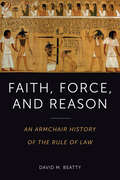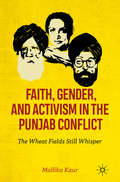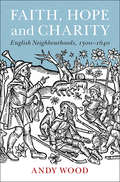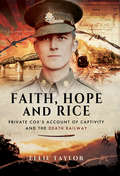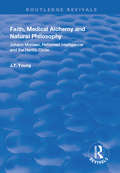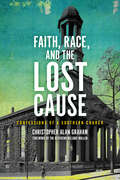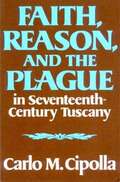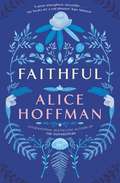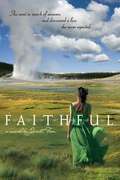- Table View
- List View
Faith in Objects
by Erin L. HasinoffIn the early twentieth century, missionary expositions were a central event in the religious life of many Americans. Hasinoff brings the untold history of the World in Boston of 1911, "America's First Great Missionary Exposition,"to light, focusing on how the material culture of missions shaped domestic interactions with evangelism, Christianity, and the consumption of ethnological knowledge. "
Faith in Paper: The Ethnohistory and Litigation of Upper Great Lakes Indian Treaties
by Charles E. ClelandFaith in Paper is about the reinstitution of Indian treaty rights in the Upper Great Lakes region during the last quarter of the 20th century. The book focuses on the treaties and legal cases that together have awakened a new day in Native American sovereignty and established the place of Indian tribes on the modern political landscape. In addition to discussing the historic development of Indian treaties and their social and legal context, Charles E. Cleland outlines specific treaties litigated in modern courts as well as the impact of treaty litigation on the modern Indian and non-Indian communities of the region. Faith in Paper is both an important contribution to the scholarship of Indian legal matters and a rich resource for Indians themselves as they strive to retain or regain rights that have eroded over the years. Charles E. Cleland is Michigan State University Emeritus Professor of Anthropology and Curator of Anthropology and Ethnology. He has been an expert witness in numerous Native American land claims and fishing rights cases and written a number of other books on the subject, including Rites of Conquest: The History and Culture of Michigan's Native Americans;The Place of the Pike (Gnoozhekaaning): A History of the Bay Mills Indian Community; and (as a contributor)Fish in the Lakes, Wild Rice, and Game in Abundance: Testimony on Behalf of Mille Lacs Ojibwe Hunting and Fishing Rights.
Faith in Their Own Color: Black Episcopalians in Antebellum New York City
by Craig D. TownsendOn a September afternoon in 1853, three African American men from St. Philip's Church walked into the Convention of the Episcopal Diocese of New York and took their seats among five hundred wealthy and powerful white church leaders. Ultimately, and with great reluctance, the Convention had acceded to the men's request: official recognition for St. Philip's, the first African American Episcopal church in New York City. In Faith in Their Own Color, Craig D. Townsend tells the remarkable story of St. Philip's and its struggle to create an autonomous and independent church. His work unearths a forgotten chapter in the history of New York City and African Americans and sheds new light on the ways religious faith can both reinforce and overcome racial boundaries. Founded in 1809, St. Philip's had endured a fire; a riot by anti-abolitionists that nearly destroyed the church; and more than forty years of discrimination by the Episcopalian hierarchy. In contrast to the majority of African Americans, who were flocking to evangelical denominations, the congregation of St. Philip's sought to define itself within an overwhelmingly white hierarchical structure. Their efforts reflected the tension between their desire for self-determination, on the one hand, and acceptance by a white denomination, on the other. The history of St. Philip's Church also illustrates the racism and extraordinary difficulties African Americans confronted in antebellum New York City, where full abolition did not occur until 1827. Townsend describes the constant and complex negotiation of the divide between black and white New Yorkers. He also recounts the fascinating stories of historically overlooked individuals who built and fought for St. Philip's, including Rev. Peter Williams, the second African American ordained in the Episcopal Church; Dr. James McCune Smith, the first African American to earn an M.D.; pickling magnate Henry Scott; the combative priest Alexander Crummell; and John Jay II, the grandson of the first chief justice of the Supreme Court and an ardent abolitionist, who helped secure acceptance of St. Philip's.
Faith in Their Own Color: Black Episcopalians in Antebellum New York City (Religion and American Culture)
by Craig TownsendOn a September afternoon in 1853, three African American men from St. Philip's Church walked into the Convention of the Episcopal Diocese of New York and took their seats among five hundred wealthy and powerful white church leaders. Ultimately, and with great reluctance, the Convention had acceded to the men's request: official recognition for St. Philip's, the first African American Episcopal church in New York City. In Faith in Their Own Color, Craig D. Townsend tells the remarkable story of St. Philip's and its struggle to create an autonomous and independent church. His work unearths a forgotten chapter in the history of New York City and African Americans and sheds new light on the ways religious faith can both reinforce and overcome racial boundaries. Founded in 1809, St. Philip's had endured a fire; a riot by anti-abolitionists that nearly destroyed the church; and more than forty years of discrimination by the Episcopalian hierarchy. In contrast to the majority of African Americans, who were flocking to evangelical denominations, the congregation of St. Philip's sought to define itself within an overwhelmingly white hierarchical structure. Their efforts reflected the tension between their desire for self-determination, on the one hand, and acceptance by a white denomination, on the other.The history of St. Philip's Church also illustrates the racism and extraordinary difficulties African Americans confronted in antebellum New York City, where full abolition did not occur until 1827. Townsend describes the constant and complex negotiation of the divide between black and white New Yorkers. He also recounts the fascinating stories of historically overlooked individuals who built and fought for St. Philip's, including Rev. Peter Williams, the second African American ordained in the Episcopal Church; Dr. James McCune Smith, the first African American to earn an M.D.; pickling magnate Henry Scott; the combative priest Alexander Crummell; and John Jay II, the grandson of the first chief justice of the Supreme Court and an ardent abolitionist, who helped secure acceptance of St. Philip's.
Faith in War: Religion and the Military in Germany, c.1500-1650 (Spektrum: Publications of the German Studies Association #31)
by Nikolas M. FunkeWhile the social and cultural history of the early modern military has greatly advanced in the last few decades, the religious dimension of the military life in the Holy Roman Empire between 1500 and 1650 has hardly been explored. The Reformation brought profound political, social and cultural upheavals, but the religiosity of the men and women who followed the Christian life in the chaos of war still represents a large gap in the historiography. Faith in War shows that confessional antagonisms lost much of their meaning during war and coexistence became a fact of army life. Connecting military and civilian social and cultural history in these ways, Nikolas Funke’s case study on this period brings new life to important current historiographical discussions in a military context, including stereotyping, confessionalization, social discipline, deviance, toleration, religious violence, and the culture of death.
Faith in the Face of Tyranny: An Examination of the Bethel Confession Proposed by Dietrich Bonhoeffer and Hermann Sasse in August 1933
by Torbjörn JohannsonIn 1933 a group of theological students in Berlin asked Dietrich Bonhoeffer and Hermann Sasse to work together with other theologians to come up with a confession that could be used to challenge nazi ideology and its inroads into the church bodies of Germany through the so-called "German Christians" who wanted to reshape Christianity into a worship of German ethnicity. The result was the August Bethel Confession named after the town in which Sasse and Bonhoeffer worked together. Unfortunately, church bureaucrats got a hold of it and watered it down, and then it was forgotten for the Barmen Declaration what was much more heavily influenced by Reformed theology and concerns and failed to even take up the question of what place Jews had in the church.This was a huge disappointment to both Bonhoeffer and Sasse who are largely regarded as two of the greatest Lutheran theologians of that era. In Faith in the Face of Tyranny, Torbjö rn Johannson takes a look at the work that both these men brought to the forgotten Bethel Confession to show just what a confessional response to national socialism and racism looks like. Today there are often calls for new confessions and declarations addressing different political ideologies and issues and well as cultural movements. This book shows what such a confession should look like and why as well as what considerations should be taken into account when looking at such a project.
Faith in the Fight: Religion and the American Soldier in the Great War
by Jonathan H. EbelFaith in the Fight tells a story of religion, soldiering, suffering, and death in the Great War. Recovering the thoughts and experiences of American troops, nurses, and aid workers through their letters, diaries, and memoirs, Jonathan Ebel describes how religion--primarily Christianity--encouraged these young men and women to fight and die, sustained them through war's chaos, and shaped their responses to the war's aftermath. The book reveals the surprising frequency with which Americans who fought viewed the war as a religious challenge that could lead to individual and national redemption. Believing in a "Christianity of the sword," these Americans responded to the war by reasserting their religious faith and proclaiming America God-chosen and righteous in its mission. And while the war sometimes challenged these beliefs, it did not fundamentally alter them. Revising the conventional view that the war was universally disillusioning, Faith in the Fight argues that the war in fact strengthened the religious beliefs of the Americans who fought, and that it helped spark a religiously charged revival of many prewar orthodoxies during a postwar period marked by race riots, labor wars, communist witch hunts, and gender struggles. For many Americans, Ebel argues, the postwar period was actually one of "reillusionment." Demonstrating the deep connections between Christianity and Americans' experience of the First World War, Faith in the Fight encourages us to examine the religious dimensions of America's wars, past and present, and to work toward a deeper understanding of religion and violence in American history.
Faith in the Great Physician: Suffering and Divine Healing in American Culture, 1860–1900 (Lived Religions)
by Heather D. CurtisRecipient of the Frank S. and Elizabeth D. Brewer Prize of the American Society of Church History for 2007Faith in the Great Physician tells the story of how participants in the evangelical divine healing movement of the late nineteenth century transformed the ways Americans coped with physical affliction and pursued bodily health. Examining the politics of sickness, health, and healing during this period, Heather D. Curtis encourages critical reflection on the theological, cultural, and social forces that come into play when one questions the purpose of suffering and the possibility of healing.Curtis finds that advocates of divine healing worked to revise a deep-seated Christian ethic that linked physical suffering with spiritual holiness. By engaging in devotional disciplines and participating in social reform efforts, proponents of faith cure embraced a model of spiritual experience that endorsed active service, rather than passive endurance, as the proper Christian response to illness and pain. Emphasizing the centrality of religious practices to the enterprise of divine healing, Curtis sheds light on the relationship among Christian faith, medical science, and the changing meanings of suffering and healing in American culture.
Faith in the Great Physician: Suffering and Divine Healing in American Culture, 1860–1900 (Lived Religions)
by Heather D. CurtisThis history of evangelical faith healing in nineteenth-century America examines the nation’s shifting attitudes about sickness, suffering, and health. Faith in the Great Physician tells the story of how participants in the divine healing movement transformed the ways Americans coped with physical affliction and pursued bodily wellbeing. Heather D. Curtis offers critical reflection on the theological, cultural, and social forces that come into play when one questions the purpose of suffering and the possibility of healing.Belief in divine healing ran counter to a deep-seated Christian ethic that linked physical suffering with spiritual holiness. By engaging in devotional disciplines and participating in social reform efforts, proponents of faith cure embraced a model of spiritual experience that endorsed active service, rather than passive endurance, as the proper Christian response to illness and pain.Emphasizing the centrality of religious practices to the enterprise of divine healing, Curtis sheds light on the relationship among Christian faith, medical science, and the changing meanings of suffering and healing in American culture.Recipient of the Frank S. and Elizabeth D. Brewer Prize of the American Society of Church History for 2007
Faith in the Time of AIDS: Religion, Biopolitics And Modernity In South Africa (Non-governmental Public Action Ser.)
by Marian BurchardtFaith of My Fathers (Chronicles of the Kings #4)
by Lynn AustinMemorable Bible-Era Fiction From Award-Winning Author <p><p> King Manaseh and his friend Joshua were nurtured together in the faith of their godly fathers. but anger toward God smolders in Manasseh's heart after his father's unexpected death, and his insecurity makes him easy prey for the false claims of sorcery and divination. <p>When Joshua stands up for the truth, the battle lines are drawn, and Joshua must flee his life of privilege. Unable to understand why his boyhood friend has turned against him, and why he must stand alone in the face of such opposition, Joshua comes perilously close to losing his faith. <p>Can Joshua rescue the faithful remnant from Manasseh's persecution? Has it all gone too far. . or will he rediscover his father's God? Faith of My Fathers is a riveting story of intrigue, deception, danger, and suspense.
Faith of My Fathers: A Family Memoir
by John Mccain Mark SalterJohn McCain is one of the most admired leaders in the United States government, but his deeply felt memoir of family and war is not a political one and ends before his election to Congress. With candor and ennobling power, McCain tells a story that, in the words of Newsweek, "makes the other presidential candidates look like pygmies." John McCain learned about life and honor from his grandfather and father, both four-star admirals in the U.S. Navy. This is a memoir about their lives, their heroism, and the ways that sons are shaped and enriched by their fathers. John McCain's grandfather was a gaunt, hawk-faced man known as Slew by his fellow officers and, affectionately, as Popeye by the sailors who served under him. McCain Sr. played the horses, drank bourbon and water, and rolled his own cigarettes with one hand. More significant, he was one of the navy's greatest commanders, and led the strongest aircraft carrier force of the Third Fleet in key battles during World War II. John McCain's father followed a similar path, equally distinguished by heroic service in the navy, as a submarine commander during World War II. McCain Jr. was a slightly built man, but like his father, he earned the respect and affection of his men. He, too, rose to the rank of four-star admiral, making the McCains the first family in American history to achieve that distinction. McCain Jr.'s final assignment was as commander of all U.S. forces in the Pacific during the Vietnam War. It was in the Vietnam War that John McCain III faced the most difficult challenge of his life. A naval aviator, he was shot down over Hanoi in 1967 and seriously injured. When Vietnamese military officers realized he was the son of a top commander, they offered McCain early release in an effort to embarrass the United States. Acting from a sense of honor taught him by his father and the U.S. Naval Academy, McCain refused the offer. He was tortured, held in solitary confinement, and imprisoned for five and a half years. Faith of My Fathers is about what McCain learned from his grandfather and father, and how their example enabled him to survive those hard years. It is a story of three imperfect men who faced adversity and emerged with their honor intact. Ultimately, Faith of My Fathers shows us, with great feeling and appreciation, what fathers give to their sons, and what endures.From the Hardcover edition.
Faith of Our Founding Fathers: A Comprehensive Study of America's Christian Foundations
by Tim LahayeSecular textbooks now fill our classrooms, while the Ten Commandments have been removed from their walls. Is this the vision held by those who worked to found this nation? What faith did our founding fathers truly believe and practice in their daily lives, and what does it really matter for us? Were they God-fearing, Bible-believing Christians or simply enlightened Deists, Transcendentalists, and Unitarians? Today the debate rages on, becoming a polarizing cultural issue, the outcome of which will lead to a vastly different nation in the years ahead. This probing study: Examines the facts that have created debate for years among educators, scholars, and historians Studies the intimate papers, diaries, and letters of the founders themselves Helps solve this mystery of our nation's past so that we can best guide its future. Meticulously documented, Faith of Our Founding Fathers by best-selling author Tim LaHaye details the Christian principles of these early Americans, and notes how the argument for the separation of church and state has led us to the vast secularization of our culture. Studying the original writings of those who shaped this nation will help Christians present the case for renewing the former vision for this great country.
Faith of the Founders: Religion and the New Nation, 1776-1826
by Edwin S. GaustadIn the lauded Faith of the Founders , revered historian Edwin Gaustad provides a careful consideration of the developing relationship between religion and the state after the American Revolution. With concise focus on Thomas Jefferson, James Madison, Benjamin Franklin, George Washington, and John Adams, Gaustad identifies seven varyingâsometimes contraryâperspectives on religion that guided the nation's founders. Faith of the Founders masterfully shows how these figures possessed an intuitive understanding of religion that helped nourish a young country. Repackaged for a new generation of readers and with a new foreword by Randall Balmer, this brief but insightful book offers a look into the founding fathers' geniusâand points to a way forward through the ideological boundaries that threaten to upend the daily doings of American government today.
Faith on the Margins: Catholics and Catholicism in the Dutch Golden Age
by Charles H. ParkerIn the wake of the 1572 revolt against Spain, the new Dutch Republic outlawed Catholic worship and secularized all church property. Calvinism prevailed as the public faith, yet Catholicism experienced a resurgence in the first half of the seventeenth century, with membership rivaling that of the Calvinist church. In a wide-ranging analysis of a marginalized yet vibrant religious minority, Charles Parker examines this remarkable revival.It had little to do with the traditional Dutch reputation for tolerance. A keen sense of persecution, combined with a vigorous program of reform, shaped a movement that imparted meaning to Catholics in a Protestant republic. A pastoral organization known as the Holland Mission emerged to establish a vigorous Catholic presence. A chronic shortage of priests enabled laymen and women to exercise an exceptional degree of leadership in local congregations. Increased interaction between clergy and laity reveals a picture that differs sharply from the standard account of the Counter-Reformation's clerical dominance and imposition of church reform on a reluctant populace.There were few places in early modern Europe where a proscribed religious minority was so successful in remaining a permanent fixture of society. Faith on the Margins casts light on the relationship between religious minorities and hostile environments.
Faith under Fire
by Edward MadiganAfter the Great War some texts by British Army veterans portrayed the Anglican chaplains who had served with them in an extremely negative light. This book examines the realities of Anglican chaplains' wartime experiences and presents a compelling picture of what it meant to be a clergyman-in-uniform in the most devastating war in modern history.
Faith, Force, and Reason: An Armchair History of the Rule of Law
by David BeattyFaith, Force, and Reason follows the evolution of the rule of law from its birth in the marshes of Mesopotamia over 4,000 years ago to its battle against apartheid in South Africa in the last twenty-five years. It is recounted through the voices of emperors and kings, judges and jurists, and popes and philosophers who have thought about what the rule of law is all about and how it works. All of law’s most momentous achievements – Justinian’s Corpus Juris Civilis, the Magna Carta, and the American Bill of Rights – and most celebrated advocates – Plato and Aristotle, Cicero, Aquinas, Edward Coke, Hugo Grotius, and John Marshall – are featured. So are law’s darkest moments: the trial of Socrates, the burning and beheading of witches and heretics, the persecution of Jews, and the proclamation of Lex Regia which legalized the dictatorial powers of Roman emperors and medieval kings. Faith, Force, and Reason challenges readers to think about the lessons of the history they have read. What does the rule of law mean in our own time? What does it demand of us as well as our political leaders?
Faith, Gender, and Activism in the Punjab Conflict: The Wheat Fields Still Whisper
by Mallika KaurPunjab was the arena of one of the first major armed conflicts of post-colonial India. During its deadliest decade, as many as 250,000 people were killed. This book makes an urgent intervention in the history of the conflict, which to date has been characterized by a fixation on sensational violence—or ignored altogether. Mallika Kaur unearths the stories of three people who found themselves at the center of Punjab’s human rights movement: Baljit Kaur, who armed herself with a video camera to record essential evidence of the conflict; Justice Ajit Singh Bains, who became a beloved “people’s judge”; and Inderjit Singh Jaijee, who returned to Punjab to document abuses even as other elites were fleeing. Together, they are credited with saving countless lives. Braiding oral histories, personal snapshots, and primary documents recovered from at-risk archives, Kaur shows that when entire conflicts are marginalized, we miss essential stories: stories of faith, feminist action, and the power of citizen-activists.
Faith, Hope and Charity: English Neighbourhoods, 1500–1640
by Andy WoodFaith, Hope and Charity explores the interaction between social ideals and everyday experiences in Tudor and early Stuart neighbourhoods, drawing on a remarkably rich variety of hitherto largely unstudied sources. Focusing on local sites, where ordinary people lived their lives, Andy Wood deals with popular religion, gender relations, senses of locality and belonging, festivity, work, play, witchcraft, gossip, and reactions to dearth and disease. He thus brings a new clarity to understandings of the texture of communal relations in the historical past and highlights the particular characteristics of structural processes of inclusion and exclusion in the construction and experience of communities in early modern England. This engaging social history vividly captures what life would have been like in these communities, arguing that, even while early modern people were sure that the values of neighbourhood were dying, they continued to evoke and reassert those values.
Faith, Hope and Rice: Private Cox's Account of Captivity and the Death Railway
by Ellie TaylorFred Cox, a young soldier in the East Surrey Regiment, was taken prisoner by the Japanese at the fall of Singapore in February 1942. The next three and a half years were spent in a series of PoW camps, notably in Thailand working on the aptly named Death Railway. Fortunately he was not one of the 12,000 Allied prisoners who perished as a result of extreme maltreatment, starvation or disease, but his health, both physical and psychological, was seriously affected. After liberation, whilst in hospital in Ceylon, Fred was nursed by Joan whom he married. Advised by the doctors to face his horrific experiences, he and Joan spent the winter of 1946 1947 getting his story down on paper. Seventy years on, sadly after his death, Faith, Hope and Rice, (which were what sustained Fred through his ordeal) can now be shared with a wider audience. Readers cannot fail to be moved by the author's and his comrades' inspiring courage and resilience in the face of extreme adversity and ever present death.
Faith, Medical Alchemy and Natural Philosophy: Johann Moriaen, Reformed Intelligencer and the Hartlib Circle (Routledge Revivals)
by John T. YoungPublished in 1998, this is a fundamental re-assessment of the world-view of the alchemists, natural philosophers and intelligencers of the mid 17th century. Based almost entirely upon the extensive and hitherto little-researched manuscript archive of Samuel Hartlib, it charts and contextualises the personal and intellectual history of Johann Moriaen (c.1592-1668), a Dutch-German alchemist and natural philosopher. Moriaen was closely acquainted with many of the leading thinkers and experimenters of his time, including René Descartes, J.A. Comenius, J.R. Glauber and J.S. Küffler. His detailed reports of relations with these figures and his response to their work provide a uniquely informed insight into the world of alchemy and natural philosophy. This study also illuminates the nature and mechanisms of intellectual and technological exchanges between Germany, The Netherlands and England.
Faith, Race, and the Lost Cause: Confessions of a Southern Church
by Christopher Alan GrahamFaith, Race, and the Lost Cause is a new history of Richmond’s famous St. Paul’s Episcopal Church, attended by Robert E. Lee and Jefferson Davis during the Civil War and a tourist magnet thereafter. Christopher Alan Graham’s narrative—which emerged out of St. Paul’s History and Reconciliation Initiative—charts the congregation’s theological and secular views of race from the church’s founding in 1845 to the present day, exploring the church’s complicity in Lost Cause narratives and racial oppression in Richmond.Graham investigates the ways that the actions of elite white southerners who imagined themselves as benevolent—liberal, even—in their treatment of Black people through the decades obscured the actual damage to Black bodies and souls that this ostensible liberalism caused. Placing the legacy of St. Paul’s self-described benevolent paternalism in dialogue with the racial and religious geography of Richmond, Graham reflects on what an authentic process of recognition and reparations might be, drawing useful lessons for America writ large.
Faith, Reason, And The Plague In Seventeenth-century Tuscany
by Carlo M. CipollaRecreates the struggles within plague-stricken Italy, relating events that led to a confrontation between the advocates of science and the followers of faith. By the late fall of 1630, the Black Plague had descended upon northern Italy. The prentice Magistry of Public Health, centered in Florence, took steps to contain and combat the scourge. In this essay, Carlo Cipolla recreates the daily struggle of plague-stricken Monte Lupo, a rustic Tuscan village, revealing in the vivid terms of actual events and personalities a central drama of Western civilization - the conflict between faith and reason, Church and state.
Faithful
by Alice HoffmanShe was disappearing inch by inch, vanishing into thin air, and then one day a postcard arrived . . . There was no return address, no signature, only a scrawled message: Say something. Shelby Richmond is an ordinary girl growing up on Long Island until one night a terrible road accident brings her life to a halt. While her best friend Helene suffers life-changing injuries, Shelby becomes overwhelmed with guilt and is suddenly unable to see the possibility of a future she’d once taken for granted. But as time passes, and Helene becomes an almost otherworldly figure within the town, seen by its inhabitants as a source of healing, Shelby finds herself attended to by her own guardian angel. A mysterious figure she half-glimpsed the night of the car crash, he now sends Shelby brief but beautiful messages imploring her to take charge of her life once more . . . What happens when a life is turned inside out? When you lose all hope and sense of worth? Shelby, a fan of Chinese food, dogs, bookshops, and men she should stay away from, captures both the ache of loneliness and the joy of finding oneself at last. From the bestselling author of The Dovekeepers comes this spellbinding, poignant and life-affirming story of one woman’s journey towards happiness – and the power of love, family and fate.‘A great atmospheric storyteller . . . Her books are a real pleasure’ Kate Atkinson ‘Alice Hoffman reminds us with every sentence that words have the power to transport us to alternate worlds’ Jodi Picoult
Faithful
by Janet FoxSixteen-year-old Maggie Bennet's life is in tatters. Her mother has disappeared, and is presumed dead. The next thing she knows, her father has dragged Maggie away from their elegant Newport home, off on some mad excursion to Yellowstone in Montana. Torn from the only life she's ever known, away from her friends, from society, and verging on no prospects, Maggie is furious and devastated by her father's betrayal. But when she arrives, she finds herself drawn to the frustratingly stubborn, handsome Tom Rowland, the son of a park geologist, and to the wild romantic beauty of Yellowstone itself. And as Tom and the promise of freedom capture Maggie's heart, Maggie is forced to choose between who she is and who she wants to be.

